My god, what a delightful experience.
Opoona is an obscure little RPG for the Wii. If you need the short version: it’s a game with lots of love and lots of flaws that managed to captivate me so much that I am actually writing a whole ass 1500 word long review of it. There we go, now I’ll say the same thing in too many words:
I’ve known of this game for several years, I might’ve even seen it at my local game store as a kid, and it has always been in my I’ll play this some day list, but what really made me want to play it was this excellent review by my friend Mei. I won’t talk about the aspects of the game she mentions, partly because she does it way better than I ever could, but mainly because I resonated with a very different side of the game. I encourage you to read it; it’s short, sweet, and really gets to the appeal of the game.
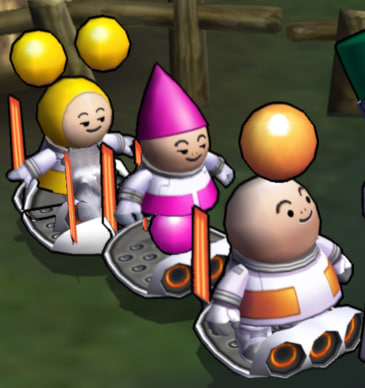
So, you’re Opoona, an adorable child of a race known as Tizian, travelling on a spaceship with your mom, dad, two siblings, two crew members and way too many dogs. Your ship crash-lands on the human planet of Landroll, where people live in domes to protect themselves from the Dark Force of the outside world and you have to work until your parents recover and your ship is repaired.
As you work more jobs, visit more domes, and befriend its inhabitants, you learn more about this society’s history and its problems, and you get to really help it in more ways than one as the stakes rise.
Beyond its basic plot, the world of Opoona (that’s Landroll, the world of the game, not Tizia, the homeworld of the main character) is another one of its main appeals. Every single dome and area in general is absolutely gorgeous.
Coupled with the beautiful soundtrack, I found myself stopping to admire the mesmerizing scenery, taking screenshots and sharing them with everyone more times than I can count. It helps that the world itself is not just pretty but also very well crafted.
Nothing floats in the void, everything is connected, everything has a sense of place, and most landmarks can be seen and accessed from more than one place, making every map feel like it has an in-universe purpose beyond just being a pretty (oh, so pretty) backdrop for the game.

Look and the pretty flowers!!
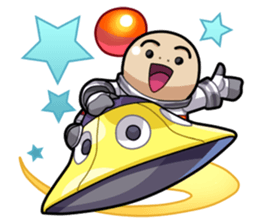
Further establishing the sense of purpose everything has is the world’s bureaucracy. This is a game obsessed with bureaucracy. Everything is a process: every door is an ID checkpoint, every elevator takes its time, everytime you hop onto a travel pod to get from dome to dome, you need to go through a multi-stage process, both to get on and off of it. Nothing is instantaneous, everything happens for a reason.
This aspect does get tedious by the time you reach the second half of the game, but I believe that tedium is worth it, as it contributes to what I find to be most compelling part of the game, what resonates the most and makes me feel involved with the world:
This is a coming-of-age story through and through. What really touched me about its execution was how well it manages to make you feel like you’re growing up.
To begin with, you are a tiny alien little guy. You’re physically small and have to look up when speaking to almost everyone; plus your design is simple, cartoony and stubby, compared to the more anime-ish look of the human characters.
You also don’t know how the world you’re in works. This is where the previously mentioned obsession with processes really comes into play. The first thing that happens after you wake up in Landroll and get told that your parents are in the Space ICU is you walking up to an elevator, hearing an error message jingle and being told that you’ve stepped onto the platform without an ID and therefore cannot use the elevator.
After you get your new ID, you’re left with insufficient directions to explore the office labyrinth that is the Tokione dome. You can follow the signs, ask people for instructions, look at the dogshit map of the place, but you will inevitably stumble and get lost before you find your way.
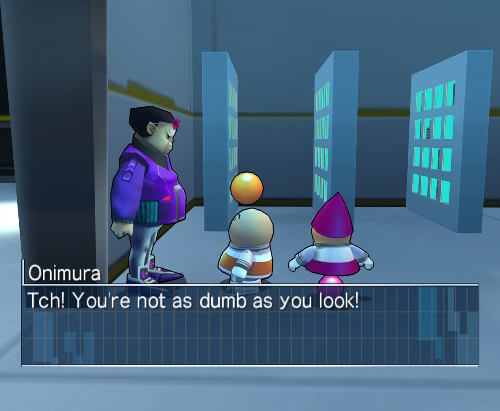
That was my first experience with almost everything: the layout of the domes, the strangely worded in-game menus (probably a result of poor localisation), the doors I couldn’t yet access, every public worker telling me “actually, this is the license issuing desk, you need to go to that other identical desk over there to get your quotas”.

oh shit
But this is not going to be the case for long. In the same way you progress by levelling up, getting more important jobs, and dealing with higher stakes in the main story, you also learn how this whole system works. You stop getting confused and anxious at the layouts, you know where the important part of every menu is, you know how to check everything you’re missing and, just like most of the in-game adults, you keep having problems with the system, but you learn how to work both through it and around it.

I don’t think any other game, or any other piece of art that I know of, has managed to capture this feeling in me. I get memories of opening a bank account for the first time, not being sure of who to talk with, what to say, what to ask, where to go, recounting the steps in my head without any confidence whatsoever. A year later, I knew all I needed, and I knew how to ask about what I didn’t already know. SO many integral parts of my life work like what initially seems like arbitrary and indecipherable rituals but ends up being a tedious but easy to maneuver process. Everytime I notice myself successfully navigating a bureaucratic aspect of society with ease, I get this feeling of “I’ve come so far and grown so much” that Opoona expertly captures.
And now, the problems with the game:
If you’re someone who absolutely needs the gameplay to be what carries a game forward, you’re probably gonna have a bad time playing this game. The combat in Opoona is original, but it never quite works. It has an active-time (or active bonbon, as the game calls it) turn-based system where your and your enemy’s actions have a cooldown and everyone attacks as soon as they can. You’re supposed to pull the stick in one direction and let go to fling your Bonbon (that floating ball the Tizians have) to the enemy at an angle, and figure out how and when to fling it to hit the right enemy on the right spot. You also have special moves and items, accessible through a more traditional menu system.
The problem is that battles fall into two distinct categories:
Scenario a: You fling your bonbon once or twice per enemy and win.
Scenario b: You absolutely need special moves and items or else the enemies will kill you in seconds.
This means you never really have a chance to experiment with any special moves other than the big AoE attacks and max heals, because every second that you spend reading what the buff, nerf or status effect moves do and trying them out is a second your party is spending getting their asses handed to them, and every battle where you have some breathing room is a battle you don’t really need any special moves in.

I mentioned tedium in a positive light, but Opoona also features the wrong kind of tedium at times. There are missions that require you to go back and forth between two domes over and over, and if it weren’t for the fast-forward button in Dolphin, they would’ve taken me hours to complete. Three missions in particular appear to be entirely random as well, one of which I abandoned and two of which I would have dropped were it not for save-states. I could go on.

this place... i hate this place...
The game also suffers from a complete lack of direction at times. Mind you, I played the fan English re-translation, which keeps the strange tone of the writing but corrects some moments where the game straight up gives you the wrong instructions and hints and I still had issues figuring out what it wanted me to do. If there weren’t any walkthroughs on the internet, I might have dropped the game altogether at the halfway point. You might have better luck with the original Japanese or other languages.
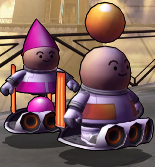
However
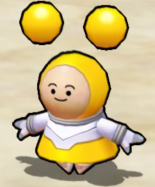
Problems with the gameplay aside, the story and worldbuilding really carry Opoona. I started out confused at the layout and all the identical looking people and after hours of a game that consists mostly of walking around and pressing A a lot, I finished the game caring SO much about the fate of the world, its inhabitants, and Opoona’s friends and family.
So yes, I would recommend that people play this game, but only if they have a patience for the more obtuse and tedious parts, and they have this walkthrough handy. It’s a beautiful game with lots of love and lots of passion that deserves to touch people’s hearts.
